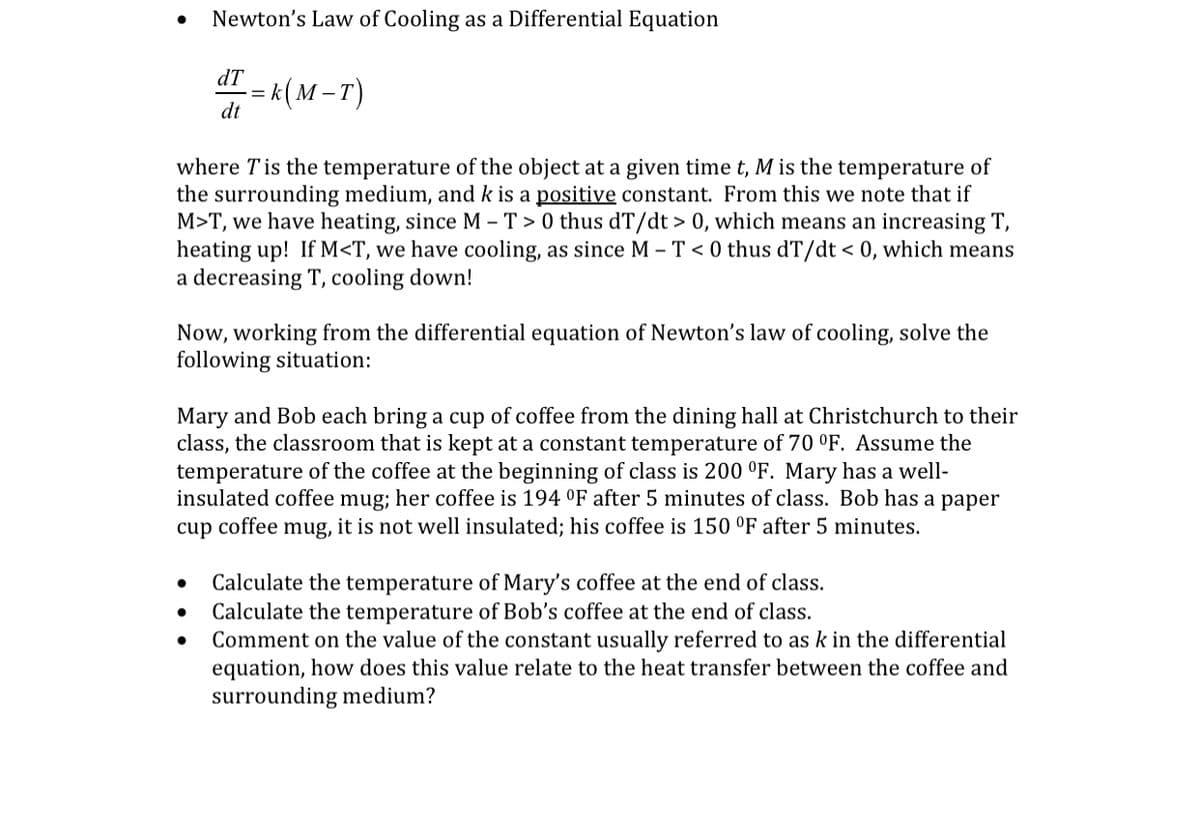Newton's Law of Cooling as a Differential Equation dT 4 = k(M – T) dt !! where T'is the temperature of the object at a given time t, M is the temperature of the surrounding medium, and k is a positive constant. From this we note that if M>T, we have heating, since M – T > 0 thus dT/dt > 0, which means an increasing T, heating up! If M
Newton's Law of Cooling as a Differential Equation dT 4 = k(M – T) dt !! where T'is the temperature of the object at a given time t, M is the temperature of the surrounding medium, and k is a positive constant. From this we note that if M>T, we have heating, since M – T > 0 thus dT/dt > 0, which means an increasing T, heating up! If M
Principles of Heat Transfer (Activate Learning with these NEW titles from Engineering!)
8th Edition
ISBN:9781305387102
Author:Kreith, Frank; Manglik, Raj M.
Publisher:Kreith, Frank; Manglik, Raj M.
Chapter5: Analysis Of Convection Heat Transfer
Section: Chapter Questions
Problem 5.12P
Related questions
Question

Transcribed Image Text:Newton's Law of Cooling as a Differential Equation
dT
k(м-т)
dt
where Tis the temperature of the object at a given time t, M is the temperature of
the surrounding medium, and k is a positive constant. From this we note that if
M>T, we have heating, since M – T > 0 thus dT/dt > 0, which means an increasing T,
heating up! If M<T, we have cooling, as since M – T < 0 thus dT/dt < 0, which means
a decreasing T, cooling down!
Now, working from the differential equation of Newton's law of cooling, solve the
following situation:
Mary and Bob each bring a cup of coffee from the dining hall at Christchurch to their
class, the classroom that is kept at a constant temperature of 70 °F. Assume the
temperature of the coffee at the beginning of class is 200 °F. Mary has a well-
insulated coffee mug; her coffee is 194 °F after 5 minutes of class. Bob has a paper
cup coffee mug, it is not well insulated; his coffee is 150 °F after 5 minutes.
Calculate the temperature of Mary's coffee at the end of class.
Calculate the temperature of Bob's coffee at the end of class.
Comment on the value of the constant usually referred to as k in the differential
equation, how does this value relate to the heat transfer between the coffee and
surrounding medium?
Expert Solution
This question has been solved!
Explore an expertly crafted, step-by-step solution for a thorough understanding of key concepts.
Step by step
Solved in 4 steps with 4 images

Knowledge Booster
Learn more about
Need a deep-dive on the concept behind this application? Look no further. Learn more about this topic, mechanical-engineering and related others by exploring similar questions and additional content below.Recommended textbooks for you

Principles of Heat Transfer (Activate Learning wi…
Mechanical Engineering
ISBN:
9781305387102
Author:
Kreith, Frank; Manglik, Raj M.
Publisher:
Cengage Learning

Principles of Heat Transfer (Activate Learning wi…
Mechanical Engineering
ISBN:
9781305387102
Author:
Kreith, Frank; Manglik, Raj M.
Publisher:
Cengage Learning